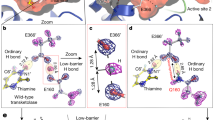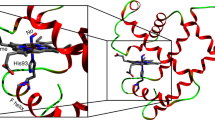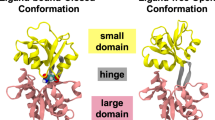Abstract
The study of cooperative ligand binding among the four subunits of haemoglobin has played a central role in the understanding of allosteric transitions in a large number of enzymes. Haem iron out-of–plane motion has been suggested to be the trigger for the cooperative transition of haemoglobin. To function as a trigger in a dynamic sense, haem–iron doming must be the first conformational change to occur following ligand dissociation. Here we present the first direct demonstration that haem–iron doming occurs on the same time scale as the breaking of the iron–ligand bond, thus establishing haem–iron doming as the primary event which lead to the R→T transition in haemoglobin.
This is a preview of subscription content, access via your institution
Access options
Subscribe to this journal
Receive 12 print issues and online access
$189.00 per year
only $15.75 per issue
Buy this article
- Purchase on Springer Link
- Instant access to full article PDF
Prices may be subject to local taxes which are calculated during checkout
Similar content being viewed by others
References
Perutz, M.F. Mechanisms of cooperativity and allosteric regulation in proteins (Cambridge University Press, Cambridge, 1990).
Monod, J., Wyman, J. & Changeux, J.-P. On the nature of allosteric transitions: a plausible model. J. molec. Biol. 12, 88–118 (1965).
Baldwin, J.M. & Chothia, C. Haemoglobin: the structural changes related to ligand binding and its allosteric mechanism. J. molec. Biol. 129, 175–220 (1979).
Baldwin, J.M. The structure of human carbonmonoxy haemoglobin at 2.7 Å resolution.. J. molec. Biol. 136, 103–128 (1980).
Perutz, M.F. Stereochemistry of cooperative effects in haemoglobin. Nature 228, 726–739 (1970).
Eaton, W.A., Henry, E.R. & Hofrichter, J. Application of linear free energy relations to protein conformational changes: The quaternary structural change of hemoglobin. Proc. natn. Acad. Sci. U.S.A. 88, 4472–4475 (1991).
Sawicki, C.A. & Gibson, Q.H. Quaternary conformational changes in human hemoglobin studied by laser photolysis of carboxyhemoglobin. J. biol. Chem. 251, 1533–1542 (1976).
Hofrichter, J., Sommer, J.H., Henry, E.R. & Eaton, W.A. Nanosecond absorption spectroscopy of hemoglobin: elementary processes in kinetic cooperativity. Proc. natn. Acad. Sci. U.S.A. 80, 2235–2239 (1983).
Martin, J.L. et al. Femtosecond photolysis of CO-ligated protoheme and hemoproteins: Appearance of deoxy species with a 350-fsec time constant. Proc. natn. Acad. Sci. U.S.A. 80, 173–177 (1983).
Lim, M., Jackson, T. A. & Anfinrud, P.A. Nonexponential protein relaxation: dynamics of conformational change in myoglobin. Proc. natn. Acad. Sci. U.S.A. 90, 5801–5804 (1993)
Findsen, E.W., Friedman, J.M., Ondrias, M.R. & Simon, S.R. Picosecond time-resolved resonance raman studies of hemoglobin: implications for reactivity. Science 229, 661–664 (1985).
Scott, T.W. & Friedman, J.M. Tertiary-structure relaxation in hemoglobin: a transient raman study. J. Am. chem. Soc. 106, 5677–5687 (1984).
Su, C., Park, Y.D. Liu, G.Y. & Spiro, T.G. Hemoglobin quaternary structure change monitored directly by transient UV resonance Roman spectroscopy. J. Am. chem. Soc. 111, 3457–3459 (1989).
Olafson, B.D., & Goddard, W.A. Molecular description of dioxygen bonding in hemoglobin. Proc. natn. Acad. Sci. U.S.A. 74, 1315–1319 (1977).
Henry, E.R., Levitt, M. & Eaton, W.A . Molecular dynamics simulation of photodissociation of carbon monoxide from hemoglobin. Proc. natn. Acad. Sci. U.S.A. 82, 2034–2038 (1985).
Kuczera, K., Kuriyan, J. & Karplus, M. Temperature dependence of the structure and dynamics of myoglobin: a simulation approach. J. molec. Biol. 213, 351–363 (1990)
Gibson, Q.H., Regan, R., Elber, R., Olson, J.S. & Carver, T.E. Distal pocket residues affect picosecond ligand recombination in myoglobin. J. biol. Chem. 267, 22022–22034 (1992).
Armstrong, R.S., Irwin, M.J. & Wright, P.E. .Soret-excited resonance raman spectrum of (carbonmonoxy) leghemoglobin: assignment of μFe-CO . J. Am. chem. Soc. 104, 626–627 (1982).
Tsubaki, M., Srivastava, R.B. & Yu, N.-T. Resonance raman investigation of carbon monoxide bonding in (carbonmonoxy)-hemoglobin and -myoglobin: detection of Fe-CO stretching and Fe-C-O bending vibrations and influence of quaternary structure change. Biochemistry 21, 1132–1140 (1982).
Kitagawa, T, Nagai, K. & Tsubaki, M. Assignment of the Fe-Ne (His F8) stretching band in the resonance raman spectra of deoxy myoglobin. FEBS Lett. 104, 376–378 (1979).
Nagai, K. & Kitagawa, T. Differences in Fe(ll)-Ne(His F8) stretching frequencies between deoxyhemoglobins in the two alternative quaternary structures. Proc. natn. Acad. Sci. U.S.A. 77, 2033–2037 (1980).
Ahmed et al. Evidence for proximal control of ligand specificity in hemeproteins: absorption and Raman studies of cryogenically trapped photoproducts of ligand bound myoglobins. Chem Phys. 158, 329–351 (1991).
Petrich, J.W., Poyart, C. & Martin, J.L. Photophysics and reactivity of heme proteins: a femtosecond absorption study of hemoglobin, myoglobin, and protoheme. Biochemistry 27, 4049–1060 (1988).
Austin, R.H., Roberson, M.W. & Mansky, P. For-infrared perturbation of reaction rates in myoglobin at low temperatures. Phys. Rev. Lett. 62, 1912–195 (1989).
Sassaroli, M., Dasgupta, S. & Rousseau, D.L. Cryogenic stabilization of myoglobin photoproducts. J. biol. Chem. 261, 13704–13713 (1986).
Gelin, B.R. & Karplus, M. Mechanism of tertiary structural changes in hemoglobin. Proc. natn. Acad. Sci. U.S.A. 74, 801–805 (1977).
Perutz, M.F. Structure and mechanism of haemoglobin. A. Rev. Biochem. 48, 327–386 (1979).
Petrich, J.W., Martin, J.-L., Houde, D., Poyart, C. & Orszag, A. Time-resolved raman spectroscopy with subpicosecond resolution: vibrational cooling and delocalization of strain energy in photodissociated (carbonmonoxy)hemoglobin. Biochemistry 26, 7914–7923 (1987).
Bangcharoenpaurpong, O., Schomaker, K.T. & Champion, P.M. A resonance raman investigation of myoglobin and hemoglobin.. J. Am. chem. Soc. 106, 5688–5698 (1984).
Author information
Authors and Affiliations
Rights and permissions
About this article
Cite this article
Franzen, S., Lambry, J., Bohn, B. et al. Direct evidence for the role of haem doming as the primary event in the cooperative transition of haemoglobin. Nat Struct Mol Biol 1, 230–233 (1994). https://doi.org/10.1038/nsb0494-230
Received:
Accepted:
Issue Date:
DOI: https://doi.org/10.1038/nsb0494-230
This article is cited by
-
Femtosecond X-ray emission study of the spin cross-over dynamics in haem proteins
Nature Communications (2020)
-
Phthalide Derivatives from Angelica Sinensis Decrease Hemoglobin Oxygen Affinity: A New Allosteric-Modulating Mechanism and Potential Use as 2,3-BPG Functional Substitutes
Scientific Reports (2017)
-
Coherent reaction dynamics in a bacterial cytochrome c oxidase
Nature (1999)
-
Concerted movement of side chains in the haem vicinity observed on ligand binding in cytochrome c′ from Rhodobactercapsulatus
Nature Structural Biology (1996)
-
Allosteric transition intermediates modelled by crosslinked haemoglobins
Nature (1995)



